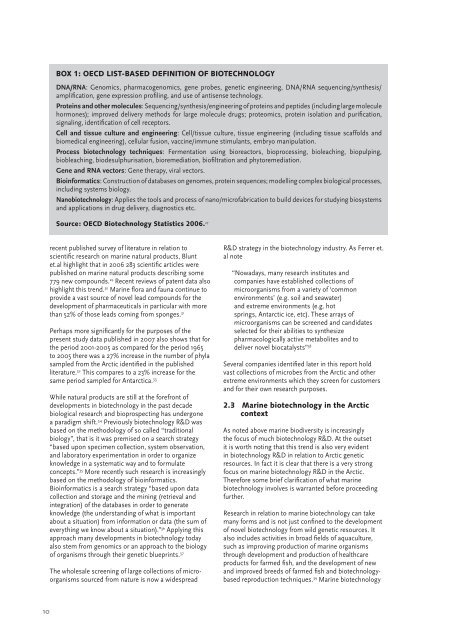Bioprospecting in the Arctic - UNU-IAS - United Nations University
Bioprospecting in the Arctic - UNU-IAS - United Nations University
Bioprospecting in the Arctic - UNU-IAS - United Nations University
You also want an ePaper? Increase the reach of your titles
YUMPU automatically turns print PDFs into web optimized ePapers that Google loves.
10<br />
Box 1: oECD LIST-BASED DEFINITIoN oF BIoTEChNoLogy<br />
DNA/RNA: Genomics, pharmacogenomics, gene probes, genetic eng<strong>in</strong>eer<strong>in</strong>g, DNA/RNA sequenc<strong>in</strong>g/syn<strong>the</strong>sis/<br />
amplification, gene expression profil<strong>in</strong>g, and use of antisense technology.<br />
Prote<strong>in</strong>s and o<strong>the</strong>r molecules: Sequenc<strong>in</strong>g/syn<strong>the</strong>sis/eng<strong>in</strong>eer<strong>in</strong>g of prote<strong>in</strong>s and peptides (<strong>in</strong>clud<strong>in</strong>g large molecule<br />
hormones); improved delivery methods for large molecule drugs; proteomics, prote<strong>in</strong> isolation and purification,<br />
signal<strong>in</strong>g, identification of cell receptors.<br />
Cell and tissue culture and eng<strong>in</strong>eer<strong>in</strong>g: Cell/tissue culture, tissue eng<strong>in</strong>eer<strong>in</strong>g (<strong>in</strong>clud<strong>in</strong>g tissue scaffolds and<br />
biomedical eng<strong>in</strong>eer<strong>in</strong>g), cellular fusion, vacc<strong>in</strong>e/immune stimulants, embryo manipulation.<br />
Process biotechnology techniques: Fermentation us<strong>in</strong>g bioreactors, bioprocess<strong>in</strong>g, bioleach<strong>in</strong>g, biopulp<strong>in</strong>g,<br />
biobleach<strong>in</strong>g, biodesulphurisation, bioremediation, biofiltration and phytoremediation.<br />
Gene and RNA vectors: Gene <strong>the</strong>rapy, viral vectors.<br />
Bio<strong>in</strong>formatics: Construction of databases on genomes, prote<strong>in</strong> sequences; modell<strong>in</strong>g complex biological processes,<br />
<strong>in</strong>clud<strong>in</strong>g systems biology.<br />
Nanobiotechnology: Applies <strong>the</strong> tools and process of nano/microfabrication to build devices for study<strong>in</strong>g biosystems<br />
and applications <strong>in</strong> drug delivery, diagnostics etc.<br />
Source: oECD Biotechnology Statistics 2006. 27<br />
recent published survey of literature <strong>in</strong> relation to<br />
scientific research on mar<strong>in</strong>e natural products, Blunt<br />
et.al highlight that <strong>in</strong> 2006 283 scientific articles were<br />
published on mar<strong>in</strong>e natural products describ<strong>in</strong>g some<br />
779 new compounds. 29 Recent reviews of patent data also<br />
highlight this trend. 30 Mar<strong>in</strong>e flora and fauna cont<strong>in</strong>ue to<br />
provide a vast source of novel lead compounds for <strong>the</strong><br />
development of pharmaceuticals <strong>in</strong> particular with more<br />
than 52% of those leads com<strong>in</strong>g from sponges. 31<br />
Perhaps more significantly for <strong>the</strong> purposes of <strong>the</strong><br />
present study data published <strong>in</strong> 2007 also shows that for<br />
<strong>the</strong> period 2001-2005 as compared for <strong>the</strong> period 1965<br />
to 2005 <strong>the</strong>re was a 27% <strong>in</strong>crease <strong>in</strong> <strong>the</strong> number of phyla<br />
sampled from <strong>the</strong> <strong>Arctic</strong> identified <strong>in</strong> <strong>the</strong> published<br />
literature. 32 This compares to a 23% <strong>in</strong>crease for <strong>the</strong><br />
same period sampled for Antarctica. 33<br />
While natural products are still at <strong>the</strong> forefront of<br />
developments <strong>in</strong> biotechnology <strong>in</strong> <strong>the</strong> past decade<br />
biological research and bioprospect<strong>in</strong>g has undergone<br />
a paradigm shift. 34 Previously biotechnology R&D was<br />
based on <strong>the</strong> methodology of so called “traditional<br />
biology”, that is it was premised on a search strategy<br />
“based upon specimen collection, system observation,<br />
and laboratory experimentation <strong>in</strong> order to organize<br />
knowledge <strong>in</strong> a systematic way and to formulate<br />
concepts.” 35 More recently such research is <strong>in</strong>creas<strong>in</strong>gly<br />
based on <strong>the</strong> methodology of bio<strong>in</strong>formatics.<br />
Bio<strong>in</strong>formatics is a search strategy “based upon data<br />
collection and storage and <strong>the</strong> m<strong>in</strong><strong>in</strong>g (retrieval and<br />
<strong>in</strong>tegration) of <strong>the</strong> databases <strong>in</strong> order to generate<br />
knowledge (<strong>the</strong> understand<strong>in</strong>g of what is important<br />
about a situation) from <strong>in</strong>formation or data (<strong>the</strong> sum of<br />
everyth<strong>in</strong>g we know about a situation).” 36 Apply<strong>in</strong>g this<br />
approach many developments <strong>in</strong> biotechnology today<br />
also stem from genomics or an approach to <strong>the</strong> biology<br />
of organisms through <strong>the</strong>ir genetic bluepr<strong>in</strong>ts. 37<br />
The wholesale screen<strong>in</strong>g of large collections of microorganisms<br />
sourced from nature is now a widespread<br />
R&D strategy <strong>in</strong> <strong>the</strong> biotechnology <strong>in</strong>dustry. As Ferrer et.<br />
al note<br />
“Nowadays, many research <strong>in</strong>stitutes and<br />
companies have established collections of<br />
microorganisms from a variety of ‘common<br />
environments’ (e.g. soil and seawater)<br />
and extreme environments (e.g. hot<br />
spr<strong>in</strong>gs, Antarctic ice, etc). These arrays of<br />
microorganisms can be screened and candidates<br />
selected for <strong>the</strong>ir abilities to syn<strong>the</strong>size<br />
pharmacologically active metabolites and to<br />
deliver novel biocatalysts” 38<br />
Several companies identified later <strong>in</strong> this report hold<br />
vast collections of microbes from <strong>the</strong> <strong>Arctic</strong> and o<strong>the</strong>r<br />
extreme environments which <strong>the</strong>y screen for customers<br />
and for <strong>the</strong>ir own research purposes.<br />
2.3 Mar<strong>in</strong>e biotechnology <strong>in</strong> <strong>the</strong> <strong>Arctic</strong><br />
context<br />
As noted above mar<strong>in</strong>e biodiversity is <strong>in</strong>creas<strong>in</strong>gly<br />
<strong>the</strong> focus of much biotechnology R&D. At <strong>the</strong> outset<br />
it is worth not<strong>in</strong>g that this trend is also very evident<br />
<strong>in</strong> biotechnology R&D <strong>in</strong> relation to <strong>Arctic</strong> genetic<br />
resources. In fact it is clear that <strong>the</strong>re is a very strong<br />
focus on mar<strong>in</strong>e biotechnology R&D <strong>in</strong> <strong>the</strong> <strong>Arctic</strong>.<br />
Therefore some brief clarification of what mar<strong>in</strong>e<br />
biotechnology <strong>in</strong>volves is warranted before proceed<strong>in</strong>g<br />
fur<strong>the</strong>r.<br />
Research <strong>in</strong> relation to mar<strong>in</strong>e biotechnology can take<br />
many forms and is not just conf<strong>in</strong>ed to <strong>the</strong> development<br />
of novel biotechnology from wild genetic resources. It<br />
also <strong>in</strong>cludes activities <strong>in</strong> broad fields of aquaculture,<br />
such as improv<strong>in</strong>g production of mar<strong>in</strong>e organisms<br />
through development and production of healthcare<br />
products for farmed fish, and <strong>the</strong> development of new<br />
and improved breeds of farmed fish and biotechnologybased<br />
reproduction techniques. 39 Mar<strong>in</strong>e biotechnology

















